26 January, 2015
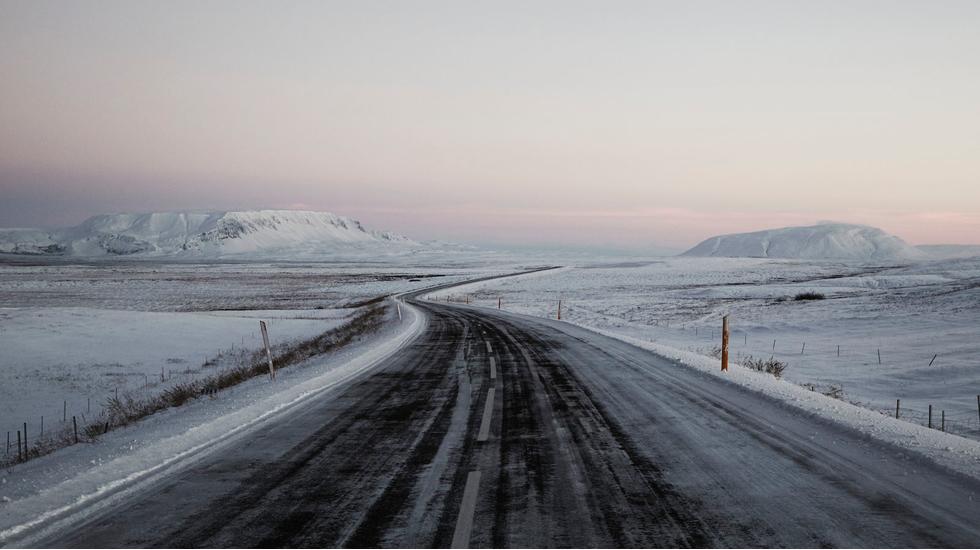
It
was the closest I’ve ever been to death. A windshield was the
only thing between me and a 30-metre drop into the icy waters of a
fjord. And black ice does not heed commands to “stop!” I was
sliding towards oblivion, the steering wheel spinning without
effect, when the tyres gripped the asphalt and rolled me back
towards life. I had survived another day in Iceland.
Near-death experiences are not all that uncommon in Iceland.
This is a place where volcanoes, avalanches, earthquakes, tidal
waves, crevasses, gales and floods pose a daily threat to
existence. It is also no nanny state. Survival instinct was built
into the very foundations of this nation – if you weren’t tough
enough, you died. Sometimes even if you were tough enough you died.
As a result you have livestock that can survive in temperatures far
below freezing and a human population with a truly lifesaving
trait: common sense.
This unfortunately didn’t translate into financial acumen when
Iceland burst onto the banking scene more than a decade ago, with
the foolhardy idea of turning a country into a hedge fund. Some
have suggested that a speedy recovery from the financial crisis has
been helped by how accustomed Icelandic people are to calamities.
But in the past few years the economy has been bolstered by a new
asset – one that may prove even harder to control than a financial
sector run by currency-swapping fishermen.
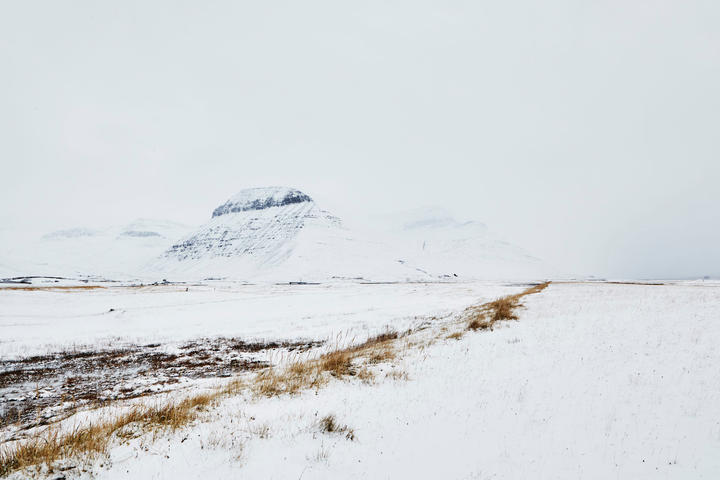
Tourists. Just under a million came last year seeking adventure
within the confines of a European, English-speaking country. Their
numbers have tripled since 2000, exceeding the local population of
323,000 threefold. They bring in healthy business, exceeding the
revenue made by fishing year on year since 2013, and open up jobs
for younger generations in the travel sector. But they also destroy
the landscape, strain the country’s infrastructure and put pressure
on emergency responders by getting themselves into tricky
situations for which they are unprepared.
In the south of the country, where glacier lagoons, black-sand
ice beaches and waterfalls dot the landscape, hoards of visitors
arrive in tour buses, regularly getting out to take photographs and
stand in the freezing wind before moving on to the next site. Even
during the winter, which over the past two years has become a
popular time to visit Iceland, the famous Jökulsárlón glacial
lagoon fills with people every day, come rain, snow or shine.
I didn’t want to be surrounded by other people. For me, one of
the draws of coming to Iceland was to see as few humans as possible
– and I imagine that many other travellers here seek a similar
escape. I wanted a real adventure and the undiscovered corners of
this country would be its setting.
There is an undeniable flaw in this sort of thinking. It’s the
same naive thought process that starts with an idealised notion of
adventure and ends in someone driving over a glacier, or being
stranded on an iceberg after trying to have a picnic on it (both
true stories). I embraced the delusion of what was possible to
achieve in Iceland as a moderately qualified traveller, believing
that I could and would ford rivers and climb volcanoes unassisted.
Maybe it’s because Iceland’s wilderness is so accessible that I
thought I could go camping in late October across the northern
coast of the country, which seemed to me a real possibility until
my enthusiasm was tempered by a round of laughter on my first night
in Reykjavik.
“It looks safer than it is,” said Egill Rafnsson, a blonde
33-year-old Icelandic guide with a penchant for puns who goes by
the name of Eagle because tourists can’t pronounce his name. He
would be taking me into the Westfjords, the northwesternmost tip of
Iceland, a peninsula just a few kilometres short of the Arctic
circle that can sometimes be unnavigable by car (at which point
your only option is to fly.) This was a journey I had originally
thought I could easily complete on my own, and in a Toyota Corolla.
“Not-so-nice-land,” he said as we stood at a viewpoint and were
pelted by freezing rain that turned to snow and back again.
The Westfjords are by far the least visited part of the country.
There is a total population here of 7,300 spread over 22,271sq km –
an area roughly the size of the state of Vermont – and most of the
land is completely undeveloped. It’s connected by a series of
treacherous roads which wind around fjords and stretch over the
flat, snowy tops of mountains – routes made more difficult by the
fact that the area is known to have the worst weather in Iceland.
By travelling this late in the season I was tempting fate, but I
had Eagle and a ridiculously robust vehicle. After the Westfjords I
would continue on my own across relatively more well-trodden areas
towards Mývatn – a crater-filled lake where volcanic energy is
harnessed – before making my way back south.
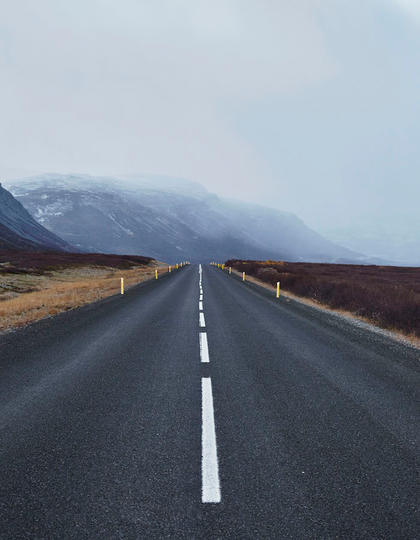
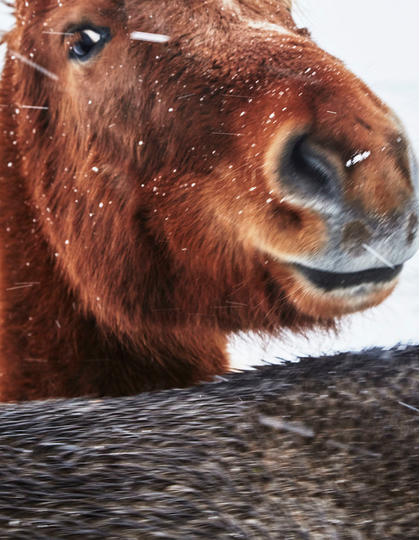
I asked Eagle why so many people come to Iceland. “The beauty of
the landscape. A little getaway from the beat of the big cities,”
he said listlessly. He took a finger off the wheel of our Nissan
Patrol which was sitting on 38-inch tyres (just think monster
truck) and pointed at a small crop of trees outside the window. “In
Iceland three trees is a forest.” He’s right, there are very few
trees – his ancestors ripped them out hundreds of years ago for
firewood, and I guess they haven’t had the willpower to grow
back.
As we climbed up Kaldidalsvegur, which translates as ‘the cold
valley’ (you can guess why) a light snow began to fall around us.
Within minutes the snow was deep and the road almost impossible to
see. A red and yellow sign blocking the road read ófært, which
means impassable. “Not for us,” Eagle said and continued
driving.
A few minutes later we saw two tourists inching along the road
in a two-wheel-drive car, bewildered at the snow around them, and I
took pity on them – they both looked terrified. I asked Eagle if he
sees this kind of thing a lot – people heading out without the
right equipment. Yes, he sees this a lot. Eagle talked about how
the explosion of Eyjafjallajökull in 2010 was almost like a
marketing campaign for the country, putting Iceland on the map for
many people who would otherwise not have thought to visit.
“We want to keep it clean, we don’t like littering, we don’t
like people’s faeces in our gardens.” [Eagle is not just saying
this, there have been several accounts of tourists defecating in
public, including at the famous Gullfoss waterfall, and the
government has had to put up signs that read ‘no human waste’ at
several high-profile sites.] “We have to have places for that to
happen. But it’s hard when you want to keep something untouched and
remote,” said Eagle. He’s not the only Icelander who thinks this. A
recent study showed that 65 per cent of the population believe the
pressure of tourism on Icelandic nature is too high.
Modern life slipped away as we drove across this lunar
landscape, where the horizon seemed impossibly distant. The only
people we saw over 100km of driving were mink and arctic fox
hunters who trudged into the snow with their guns held tightly
across their chests. Outside the car the temperature had dropped
from this morning’s 5C to -5C and the wind whipped the finest
particles of snow into my face. A light dusting had settled on the
black mountains surrounding the valley, clothing them in a shroud
of white lace. I heard nothing. I saw nothing. Except the outline
of a road and white over black. And I was only an hour away from
Reykjavik.
Axlar-Björn, Iceland’s most prolific serial killer, lived and
operated his murderous trade in the Snæfellsnes Peninsula, a wild
outcrop of land halfway between Reykjavik and the Westfjords. This
was 400 years ago, but as we drove towards Hótel Búðir, where we
would bed down for the night, the scene was set for the perfect
murder. Standing in front of the opaque grey of the Atlantic Ocean
was a solitary building – a church with a phosphorescent cross
glowing in the twilight. Next to the church, a raven floated on an
air stream I couldn’t see. The Icelandic landscape had done all my
imagination’s work for me.
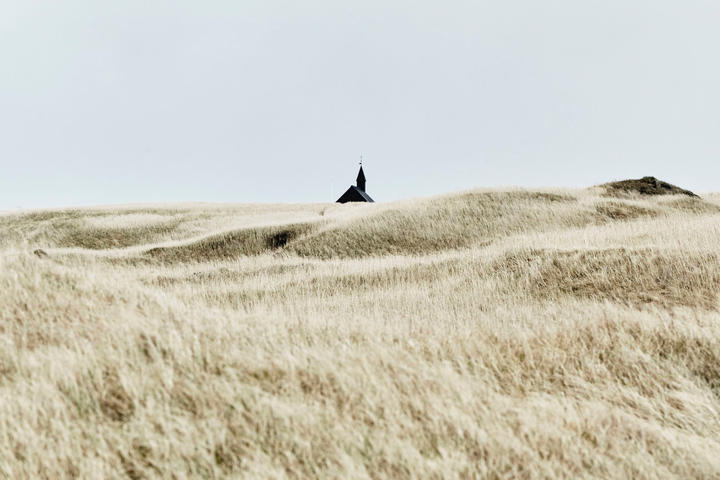
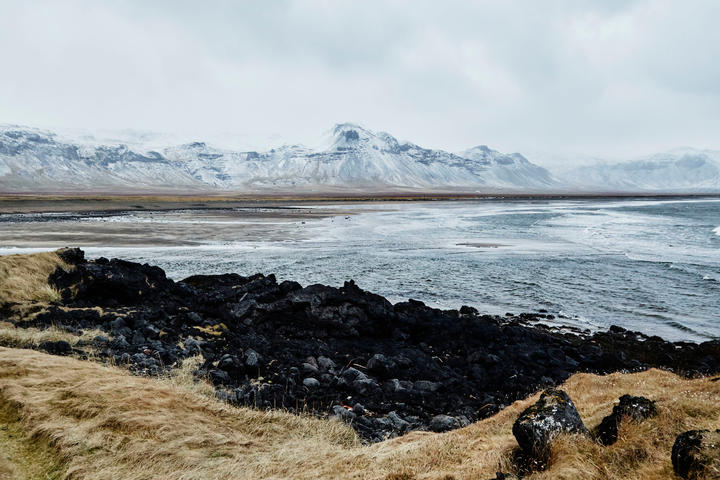
I like to think that Iceland’s landscape has inspired the
countless musicians and writers this country has produced. More
books are read and written per capita here than anywhere else in
the world. (One in ten Icelanders have written a book.) Their
musicians have clout on the international stage – Björk’s and Sigur
Rós’ unearthly tracks mesmerised audiences around the world,
introducing the island’s music to a global market. Music is an
important part of life for all Icelanders. You’ll find many people
in Reykjavik walking around with guitars strapped to their backs or
synthesisers stuffed into a bag, getting ready for one of the many
annual music festivals here. I assumed that an incredible excess of
space and time is what inspires these artists most.
“It’s mostly boredom,” Eagle said when I brought this up. He had
an amazing ability to answer my incessant string of questions with
revealing dead-end responses. “When’s the most scared you’ve ever
been?” I asked. “Don’t know,” he replied.
That night as we ate reindeer and cormorant in the candlelit
dining room, the thick walls suddenly felt less substantial, and
the rawness of the outdoors was palpable. Hótel Búðir sits about
100 metres inshore from the Atlantic coast on a grassy knoll that’s
battered constantly by wind. I shivered violently as I smoked
outside after dinner, and when Eagle ventured further away from the
building I followed him into the dark, turning a corner only to be
blasted by a gale. I quickly retreated. The old house howled
through the night, reminding all those inside their cosy beds that
a wall was the only thing between them and the cold, dark
night.
of many, many fjords that we negotiated, as the roads move
around each peninsula like a pencil tracing the outside of a hand.
The route was punctuated every so often by the crossing of a fjord
mountain – flat, high places where absolutely nothing exists but
snow, rock and the invariable frozen lake, and the horizon extends
for miles and miles. Your perception of your own significance in
this world quickly diminishes – you are tiny, a moving black speck
surrounded by a world of white.
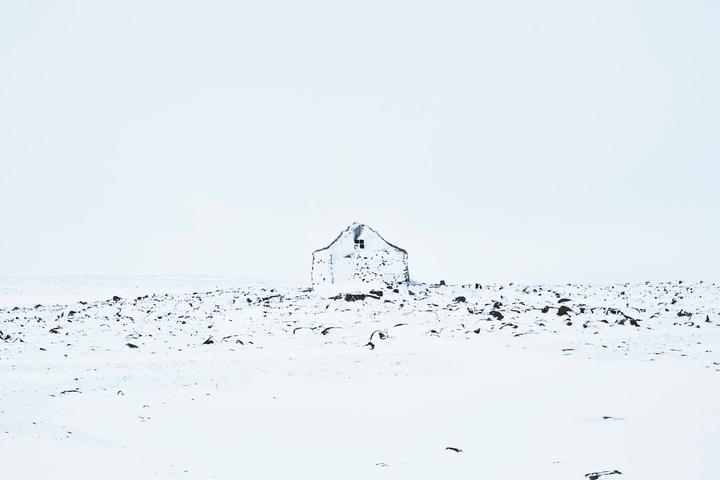
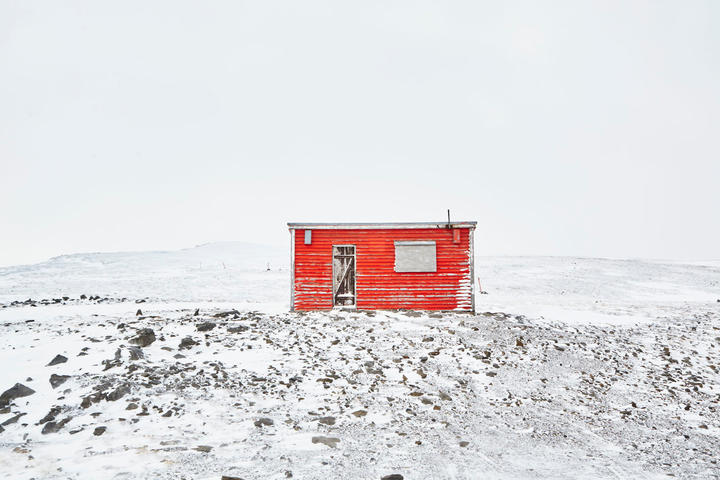
We were about an hour away from our destination of Ísafjörður,
the largest town in the Westfjords with a population of around
2,600, when this moving black speck almost disappeared for good.
With a sheer drop on our right and a mountain to our left, Eagle
lost control of the car. Our wheels slipped on invisible ice and
the headlights shone into the blackness of the fjord below, but
Eagle reacted quickly, gently taking hold of the wheel and bringing
us back into the centre of the road. I remembered again what he had
told me on the first day: “It looks safer than it is.”
In the morning over steaming cups of coffee he would say to me:
“Remember when you asked me what’s the most scared I’ve ever been
and I couldn’t answer you? It was last night.”
In this toy town hemmed in by imposing mountains that frequently
cause avalanches, you’ll find a school, a hospital, an airport and
shops and restaurants – but in the winter you won’t find sunlight.
The surrounding mountains block out any rays and the sun doesn’t
climb high enough to shine on the town. By 9AM the sun was up but
the light was hampered by thick clouds. It was a Sunday morning and
most people were at home eating eggs and bacon. The roads were
almost impossible to walk on even with proper boots, such was the
thickness of the ice on the asphalt, so I shuffled instead. I
watched a giant icicle fall on the hood of a car right before the
driver unlocked the door, and after that I stayed away from the
edges of buildings. It was all very quaint and quiet and cold. It
was hard to imagine that come summer this town would fill with
tourists from ferries that offload over 3,000 passengers at a
time.
Originally a fishing town, Ísafjörður grew as a busy trading
post from the 16th century onwards, but many of its inhabitants
still make their living from the fish that live in the frigid North
Atlantic. Eagle told me that the fishermen here didn’t learn to
swim until very recently, as it was viewed merely as a way to
prolong certain death caused by hypothermia. Fishermen would head
out each day, wrapping themselves in fish skin and thick lamb’s
wool, and if they fell in close enough to shore sometimes their
wives would watch them perish, the couples able to yell last words
to each other. Looking at the steel grey of the fjord water I could
see why they didn’t bother with swimming, and I wondered what the
fishermen of the past would think of that morning’s handful of
recreational kayakers floating across the water.
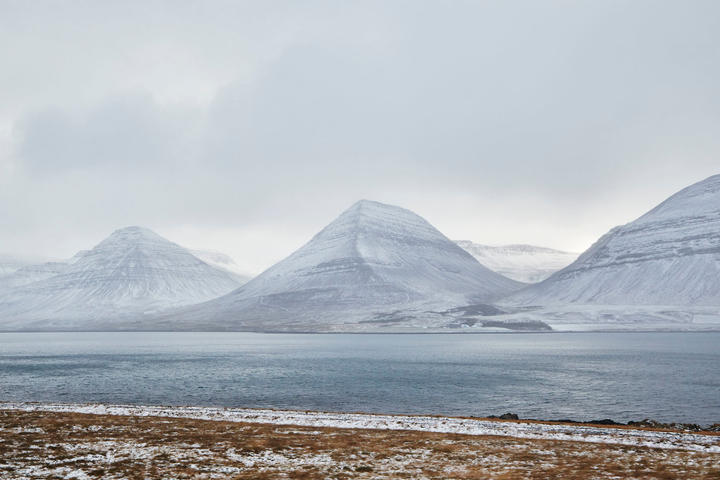
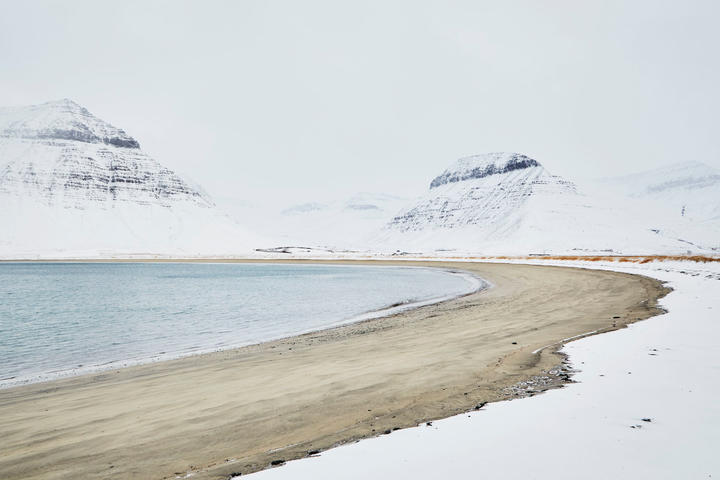
Later that day we drove past a bright green house in Þingeyri, a
town of 250 people about 45km south of Ísafjörður. Eagle told me
that it’s owned by a Belgian/Danish couple who bought the house
years ago and restored it, expanding it originally into a coffee
shop for locals and tourists and then branching out into horse and
bicycle rental. They weren’t home that day, but later over a phone
call I asked Wouter Van Hoeymissen and his wife Janne Kristensen
why they decided to start a family and a business in the middle of
nowhere.
“We fell in love with the beauty of the country like most people
do when they travel to Iceland,” Wouter said. “It can be pretty
boring here – nothing to do, no one to talk to. My best friend is
80 years old. But it is beautiful and peaceful.” Wouter and his
wife have seen a dramatic jump in the number of tourists coming to
the area, even though they live in the least-visited part of
Iceland. “The biggest change for us is also what kind of tourists
we’re getting. Four years ago you got more adventure-minded people,
explorers with more common sense.”
He believes that Iceland will struggle with a lack of
information about how dangerous the country can be, and says they
desperately need more infrastructure to protect the wildlife,
adding: “I think Icelanders are about to completely fuck up their
tourism industry in the next five years.”

I talked about this with Baldvin Jónsson, who has been a guide
in Iceland for 18 years, and takes tourists into the highlands and
beyond, as well as working as a rescuer. He also believes that a
lot of work needs to be done to educate tourists and preserve the
unspoiled landscape of the country.
“I usually start all my tours by trying to terrify people. It
sounds nasty to say it but you often need to use strong words to
get them to respect what they’re getting into.” He says the
government has been far from proactive in addressing how things
should move forward. “Most tourists claim unspoiled nature is the
reason they come to visit. We need to protect the land and at the
same time find ways for people to be able to enjoy it, it’s a
delicate balance.” One solution he suggested was to increase
infrastructure only in the lowlands, near the ringroad, where most
tourists go in any case.
One of the most pressing topics in Iceland right now is a
government proposal to create a new power line running through the
highlands, which is one of the largest untouched areas of
wilderness in Europe. Björk and writer-environmentalist Andri Snær
Magnason recently protested against the plans, calling on the
people of Iceland to sign a petition and prevent the project from
moving forwards. Baldvin said he was also very concerned about what
the plan would mean for the highlands, as building roads there
would give people access to so much more of the area.
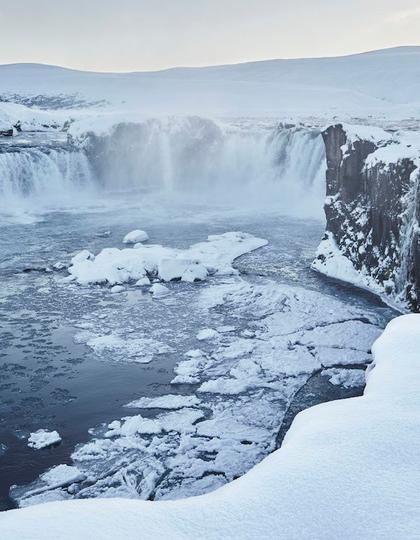
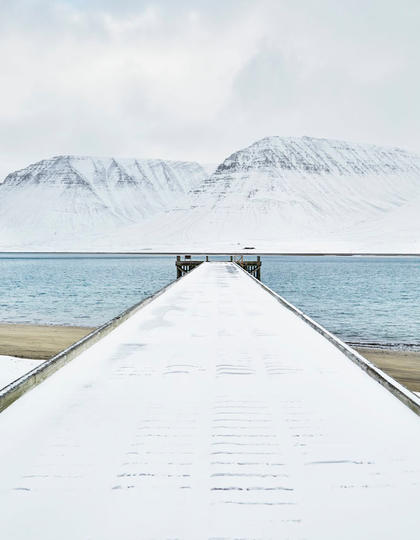
“If you build roads in the highlands you’ll find that people
will come. That traffic will create demand for more infrastructure
and cause a spiralling effect. It will become a lot more difficult
to find places where you can see unspoiled nature.”
At that moment, I didn’t have any problem finding unspoiled
landscapes, as the majestic Dynjandi waterfall came into view. From
across the water it looked frozen, an unmoving wall of water
pressed up against the mountain. But when we got out at the foot of
the waterfall it was very much in motion, and a fine mist landed on
my coat. Its wide spread of water looked like the veil of a bride,
the liquid’s thunderous pounding made louder by the fact that there
was nothing else moving in the fjord.
As we made our way south towards the foot of the Westfjords –
where I would take a bus that would bring me towards Mývatn – Eagle
warned me that the drive coming up could get a little hairy because
of three challenging mountain passes. The weather wasn’t great that
day either – in areas thick snow made visibility poor and the wind
was so strong it would bend our antennas until they were horizontal
to the road. I dug my fingernails into the leather of the car seat
as we began the descent of our first mountain, and I knew then that
challenging wasn’t an accurate enough description for what we were
about to attempt. Imagine a two-lane road. Cut the road in half.
Then paint a line down the middle. And then cover half of that in
drift snow. Add a gradient of 10 per cent and 25 hairpin turns. And
sheer cliff drops for the entire way down. Not-so-nice land after
all.
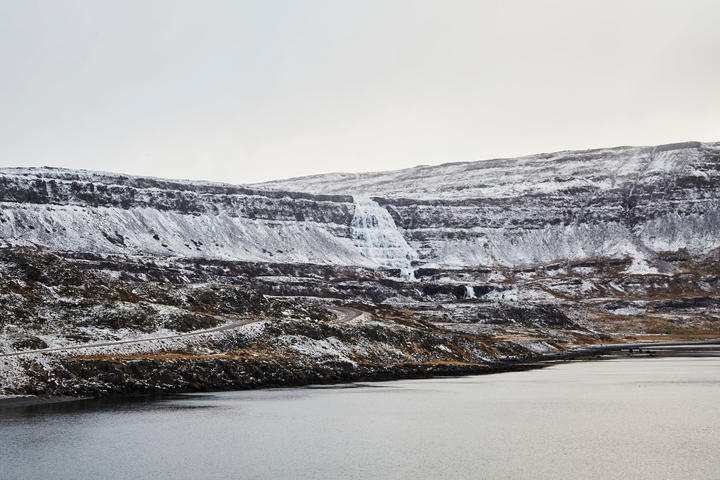
But I was rewarded about an hour later when we crossed the
second mountain as the sun was setting. The sky turned pink, and so
did the snow we were driving over, velvet powder pressed underneath
the wheels. The clarity was so good at the top of that mountain
that by dusk, when all I could see were the headlights of cars
miles and miles away, it felt almost as though we were flying.
I could smell Mývatn from miles away. A powerful sulphuric
stench that filtered through the freezing air. It was as if the
Earth had indigestion, a smell emanating not from the lake the area
is named after, but all the volcanic activity around it. Mývatn
looks like an icy soup bucket, a shallow pool of water filled with
pseudo-crater islands that’s a paradise for various bird species.
In double-digit subzero temperatures and fading light along with
the gently steaming vents surrounding the water, it resembled a
Tolkien-esque badland. As I drove towards my hotel for the night, I
passed a woman pushing a pram. The thermometer read -11C.
“The water smells bad, always,” the woman at the Vogafjós
Guesthouse reception told me about the showers. Behind her there
was a glass wall and behind that was a dairy farm where cows were
being milked. A glass tube filled with white liquid ran around the
inside of the room. She saw me staring. “Yes, it’s milk.”
We were about 500km from Reykjavik. The guests sitting around me
had travelled far to get here, and I liked them for it. Over 50 per
cent of them were Asian, and they in particular had come a very
long way to freeze in northern Iceland while sitting next to a cow
(however cool the concept of blending a restaurant with a dairy
farm was.) But they loved it. In the morning over breakfast they
went outside for an impromptu photo shoot just as the sun was
coming up. I ate another slice of geysir (rye bread) and made my
way towards the Krafla volcano.
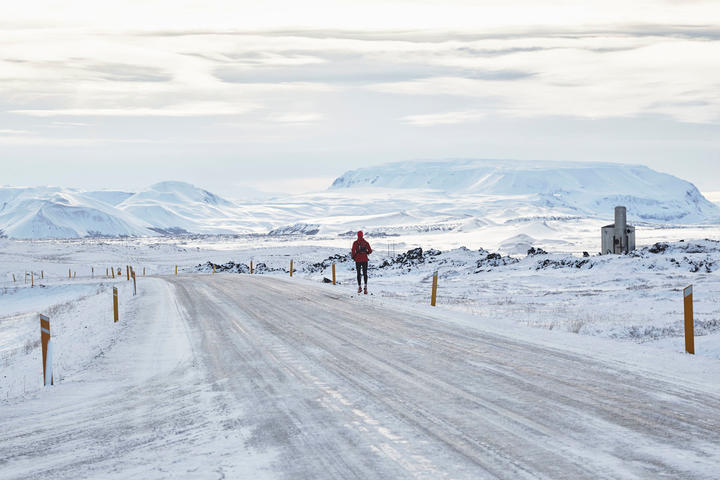
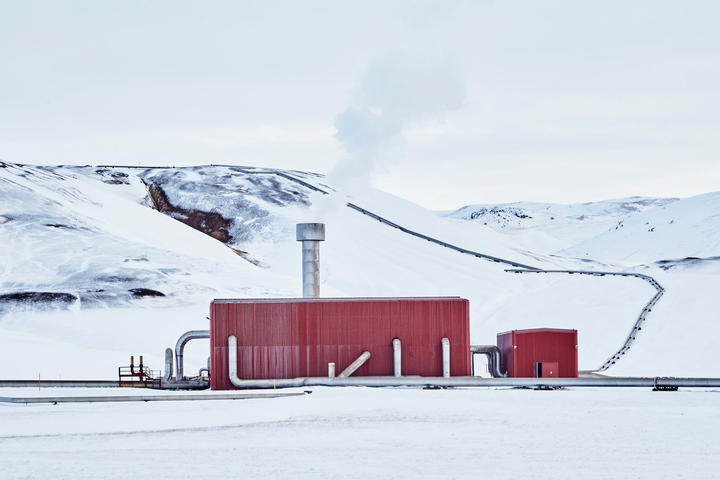
This very active volcano is also home to the Krafla power
station, the country’s largest geothermal power station, which
draws heat from a total of 33 boreholes. In the 1970s and 80s
several eruptions caused a magma chamber to emerge, and recent
drilling found magma at a depth of only 2.1km. This is energy
coming from the centre of the earth, and it’s what makes Iceland
one of the few places on the planet that is completely
self-sustaining without the use of fossil fuels.
After a soak at Mývatn baths, the north’s less-crowded, smaller
version of the blue lagoon, I left for the south. A five-hour ride
over gravel roads with thick fog and blindheads ensued, but there
was no ice, the temperature had warmed to 8C. This was supposedly
Highway 1 – the A-road – but there were areas that still weren’t as
developed as the rest of the island. At one point a few rocks
painted yellow deposited on the side of the road served as the only
warning that there was a hairpin turn coming up.
When I arrived in the southeast town of Höfn late that night, I
was relieved to have made it all the way down in one piece. I was
still in Iceland now, but it wasn’t the dangerous and unexpected
wilderness that had both enchanted and frightened me. There was
still not much development, but there were streetlights here and
there, guardrails on the roads, and most significantly, tourists.
Thousands of them. In cars and in buses.
I watched on the icy beach as photographers with lenses longer
than their arms waded into the water to get a better shot of an
iceberg. Later, on a famous beach near the southern town of Vík, a
couple climbed up the slippery rock face of a cliff for a photo
opportunity. I watched as a family with two young children
clambered down a slippery cave to look at the boiling water pool at
its base. And as a large tour bus left the famous waterfall of
Seljalandsfoss at dusk, I found rubbish lining the trail – the
first I had seen in many days.
Here in the more developed south, visitor numbers are high and
there isn’t enough infrastructure to support them, or keep up with
all the effects they have on the environment. This time round the
stability of Iceland’s economy depends not on intangible numbers in
banks and trades, but in the preservation of the land itself. If
the government doesn’t invest in creating places for all these
visitors then its wilderness will be jeopardised. But putting up
fences and guardrails is an inherently un-Icelandic thing to
do.
On my way back to Reykjavik, I passed a sign pointing right,
which I intuitively followed to the great lip of a glacier, curving
into a valley. At the start of the trail a sign warned about the
many dangers of exploring the glacier: “Some have never returned
from a glacier visit, their fate still unknown.” I walked towards
the glacier across a field of wet sand and shallow water – the
volume of the ice was threatening, its slow grinding movement clear
enough to hear. I wanted to get closer, but I stopped and I walked
back to the car instead.
If you decide to drive around Iceland be sure to start your trip
with a night at the 101 Hotel in Reykjavik and end it at the ION
Adventure Hotel in Nesjavellir, about a 45-minute drive from
Reykjavik. A double room at 101 Hotel starts from £175, book your
stay at 101hotel.is. Double rooms start from £158 at the ION
Adventure Hotel, reserve your room at ioniceland.is.
Airbnb is an excellent choice for
remoter areas in the country.
If you’re looking for a guide to take you on any adventure
around the island use Adventure Patrol.